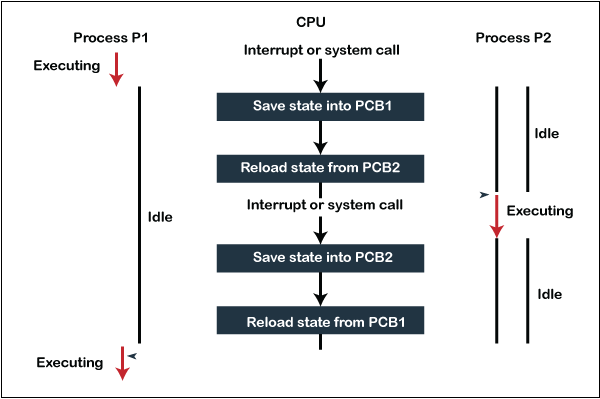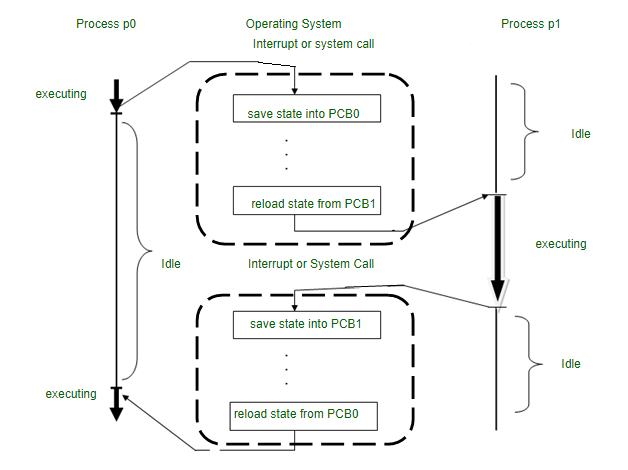In Context switching the state of the process (or thread) is stored so that it can be restored and execution can be resumed from the same point later. Context switching enables the multiple processes to share the same CPU.
A context switching helps to share a single CPU across all processes to complete its execution and store the system's tasks status. When the process reloads in the system, the execution of the process starts at the same point where there is conflicting.
Following are the reasons that describe the need for context switching in the Operating system.
- The switching of one process to another process is not directly in the system. A context switching helps the operating system that switches between the multiple processes to use the CPU's resource to accomplish its tasks and store its context. We can resume the service of the process at the same point later. If we do not store the currently running process's data or context, the stored data may be lost while switching between processes.
- If a high priority process falls into the ready queue, the currently running process will be shut down or stopped by a high priority process to complete its tasks in the system.
- If any running process requires I/O resources in the system, the current process will be switched by another process to use the CPUs. And when the I/O requirement is met, the old process goes into a ready state to wait for its execution in the CPU. Context switching stores the state of the process to resume its tasks in an operating system. Otherwise, the process needs to restart its execution from the initials level.
- If any interrupts occur while running a process in the operating system, the process status is saved as registers using context switching. After resolving the interrupts, the process switches from a wait state to a ready state to resume its execution at the same point later, where the operating system interrupted occurs.
- A context switching allows a single CPU to handle multiple process requests simultaneously without the need for any additional processors.
Exmaples of Context Switching
Suppose that multiple processes are stored in a Process Control Block (PCB). One process is running state to execute its task with the use of CPUs. As the process is running, another process arrives in the ready queue, which has a high priority of completing its task using CPU. Here we used context switching that switches the current process with the new process requiring the CPU to finish its tasks. While switching the process, a context switch saves the status of the old process in registers. When the process reloads into the CPU, it starts the execution of the process when the new process stops the old process. If we do not save the state of the process, we have to start its execution at the initial level. In this way, context switching helps the operating system to switch between the processes, store or reload the process when it requires executing its tasks.
Context switching triggers
Following are the three types of context switching triggers as follows.
- Interrupts
- Multitasking
- Kernel/User switch
Interrupts: A CPU requests for the data to read from a disk, and if there are any interrupts, the context switching automatic switches a part of the hardware that requires less time to handle the interrupts.
Multitasking: A context switching is the characteristic of multitasking that allows the process to be switched from the CPU so that another process can be run. When switching the process, the old state is saved to resume the process's execution at the same point in the system.
Kernel/User Switch: It is used in the operating systems when switching between the user mode, and the kernel/user mode is performed.
What is the PCB?
A PCB (Process Control Block) is a data structure used in the operating system to store all data related information to the process. For example, when a process is created in the operating system, updated information of the process, switching information of the process, terminated process in the PCB.
Steps for Context Switching
There are several steps involves in context switching of the processes. The following diagram represents the context switching of two processes, P1 to P2, when an interrupt, I/O needs, or priority-based process occurs in the ready queue of PCB.

As we can see in the diagram, initially, the P1 process is running on the CPU to execute its task, and at the same time, another process, P2, is in the ready state. If an error or interruption has occurred or the process requires input/output, the P1 process switches its state from running to the waiting state. Before changing the state of the process P1, context switching saves the context of the process P1 in the form of registers and the program counter to the PCB1. After that, it loads the state of the P2 process from the ready state of the PCB2 to the running state.
The following steps are taken when switching Process P1 to Process 2:
- First, thes context switching needs to save the state of process P1 in the form of the program counter and the registers to the PCB (Program Counter Block), which is in the running state.
- Now update PCB1 to process P1 and moves the process to the appropriate queue, such as the ready queue, I/O queue and waiting queue.
- After that, another process gets into the running state, or we can select a new process from the ready state, which is to be executed, or the process has a high priority to execute its task.
- Now, we have to update the PCB (Process Control Block) for the selected process P2. It includes switching the process state from ready to running state or from another state like blocked, exit, or suspend.
- If the CPU already executes process P2, we need to get the status of process P2 to resume its execution at the same time point where the system interrupt occurs.
Similarly, process P2 is switched off from the CPU so that the process P1 can resume execution. P1 process is reloaded from PCB1 to the running state to resume its task at the same point. Otherwise, the information is lost, and when the process is executed again, it starts execution at the initial level.
Below is the difference between context switching and swapping
1. Context switching :
An operating system uses this technique to switch a process between states to execute its functions through CPUs. It is a process of saving the context(state) of the old process(suspend) and loading it into the new process(resume). It occurs whenever the CPU switches between one process and another. Basically, the state of CPU’s registers and program counter at any time represent a context. Here, the saved state of the currently executing process means to copy all live registers to PCB(Process Control Block). Moreover, after that, restore the state of the process to run or execute next, which means copying live registers’ values from PCB to registers.

2. Swapping :
This is the process by which a process is temporarily swapped (moved) from the main memory (RAM) to the secondary memory (Disk). The main memory is fast but has less space than secondary storage, so the inactive processes are moved to secondary memory, and the system swaps the memory from secondary to the main memory later. During swapping, most of the time is spent transferring information, and the amount of memory swapped is directly proportional to the total time. Swapping has been divided into two more concepts: Swap-in and Swap-out.
Swap-in is the process of removing a program from a hard disk and moving it back to the main memory or RAM.
Swap-out removes a program from RAM or main memory and moves or stores it to the hard disk or secondary storage.